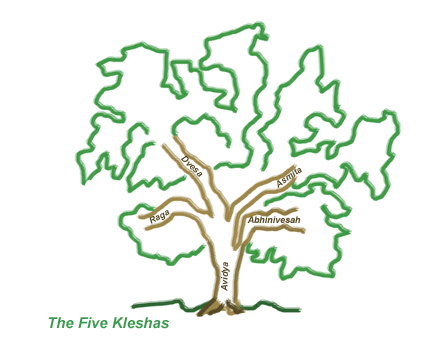Right after the Yoga Sutra describes Kriya Yoga, it explains the five reasons we are bound. These troubles, or afflictions, are known as the kleshas: [1]
- Ignorance (avidya)
- Ego (asmita)
- Attachment to Pleasure (raga)
- Aversion to Pain (dvesa)
- Fear of Death (abhinivesah)
These five afflictions are often depicted as a tree. Avidya is the trunk of the tree, and the other four kleshas sprout from it. The Samkhya emphasis on viveka, knowing the real nature of the universe, is echoed in Classical Yoga’s emphasis on avidya, or ignorance, as the chief affliction we suffer. Destroy avidya and all the other troubles go away.
Asmita is the ego. The problem with ego is not the fact that we have one; it is useful and even necessary to have an ego in order to function and live. The problem arises when the ego believes it is the Self. If all we do is in service of the little self, our life will be sorrowful. When we serve our higher Self, liberation becomes possible.

Yin Yoga is especially good at giving us time to practice watching raga and dvesa. As we hold the poses, as we remain outside our comfort zone, aversion arises. We resolve not to move, and instead we simply watch the aversion come and eventually go. It goes away only to be replaced by some new aversion. As we finally release the pose we are flooded with pleasant sensations. The joy of coming out of a yin pose can create attachment. We want to stay and linger in this wonderful feeling. But, we again simply watch the pleasure, without reacting, and move on to the next pose.
The practice we do on our yoga mats prepares us to face challenges at other times. We begin to recognize our inner habits. We notice and remark to ourselves, “Ow this is aversion!” We notice, saying, “Ahhh this is attachment!” Knowing that these afflictions, or hindrances, are constantly arising, we can consciously choose to not react to them or perhaps to react to them, if that is appropriate. But now, because we are aware, the choice is consciously made. Our reactions are no longer automatic.
The final klesha is said to be the most difficult to overcome: abhinivesah. This is the clinging to life. Even the most advanced yogis may fail to let go of this last affliction. If at the time of death there is the slightest hint of the thought, “No! I don’t want to go,” that person is doomed to return and try again.
(Next: Ashtanga – The Eight Limbs )
